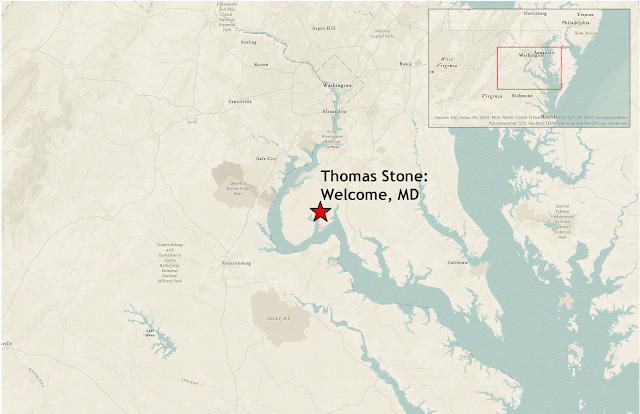Founding Fathers - Thomas Stone
Thomas Stone
Born: 1743 (Welcome, MD)
Died: October 5, 1787 (Alexandria, VA)
For this week's post, I decided to let my youngest daughter (long-time readers will remember her as Whirly) pick which signer we should learn about next. After a quick review of the available names she selected Thomas Stone from Maryland, so here we go. While the month and day of his birth may never have been recorded, history tells us that this young man was born at his family's home named Poynton Manor at the southern end of the colony. The estate had originally been given to his grandfather, William Stone, in 1654 after his notable service as the governor of Maryland under Lord Baltimore. Young Thomas was therefore born to a respected family, the second son of David and Elizabeth Stone. His education did not come easily, however, as he had to ride his horse over 10 miles each day to study under his tutor, named Mr. Blaizedel, before having to borrow money to continue his pursuit of a legal career in spite of his family's considerable wealth. After learning under a respected lawyer named Thomas Johnson, who would later become the state's first elected governor, Stone was admitted to the bar in 1764 and moved north to Frederick, Maryland, to establish his own legal practice.
Continuing his pattern of working hard to become successful, Thomas Stone established and routinely traveled a circuit between Frederick, Annapolis, and Port Tobacco to maintain his practice in multiple locations, which was a grueling and dangerous practice. His work paid off, however, and as his practice grew so did his family. In 1768 he married Margaret Brown and built a home for her on his 400 acre property in Port Tobacco, near Stone's boyhood home, where the couple raised their three children. When David Stone died five years later and left his entire estate to his eldest son, Thomas built an addition to his home and took in his younger four brothers and two sisters. The following year, 1774, was a pivotal year for the small town lawyer as he was selected to join Maryland's Committee of Correspondence that communicated regularly with patriot leaders from other colonies. Although he was regarded as being a cautious pacifist, Stone also promoted colonial freedoms and anti-British policies. He was elected to the Second Continental Congress the following year and arrived in Philadelphia in May, 1775, shortly after the fighting at Lexington and Concord officially started the war for independence.
Thomas Stone still hoped for a peaceful resolution with Britain, and the delegates were strictly instructed by Maryland's assembly to be very cautious about supporting any move to sever ties with the Crown. Stone favored a cautious approach but saw war as being less distasteful than sacrificing liberty, and when the majority of delegates moved to vote for independence, the state leaders in Annapolis permitted their representatives to follow suit. Even after signing the Declaration, Stone continued to hold out hope for a peaceful resolution, but at the same time he was part of the committee that was drafting a new government under the Articles of Confederation. While he continued to serve in Philadelphia, his wife Margaret came to visit and he took the opportunity to have her inoculated against smallpox. She reacted poorly, however, and became so sick that Stone opted not to accept his re-election to Congress and returned to Annapolis to care for her as she became increasingly ill. Instead, he accepted a position in the state senate where he could continue to serve while remaining close to home while also tending to his law practice which remained lucrative and well-respected. He attended a few congressional meetings in 1784 when they met in Annapolis, even serving briefly as the body's president, but retired from both law and public service in 1785. Margaret died in 1787 at the age of 36 and he declined to participate in the Constitutional Convention. Distraught, he decided to leave Maryland and travel to Europe. He never made it there - at the age of 44 and just four months after his wife's passing, Thomas Stone died in Alexandria, Virginia, while awaiting the ship that was to take him abroad.
The signature of Thomas Stone can be found as the fourth name on the third column beneath the Declaration of Independence.



Comments
Post a Comment